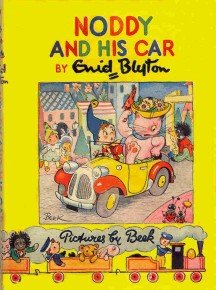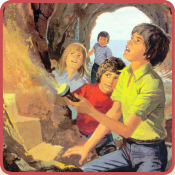
Noddy and His Car

Book Details...
First edition: 1951
Publisher: Sampson Low
Illustrator: Harmsen Van der Beek
Category: Noddy
Genre: Fantasy
Type: Novels/Novelettes
Publisher: Sampson Low
Illustrator: Harmsen Van der Beek
Category: Noddy
Genre: Fantasy
Type: Novels/Novelettes
On This Page...
Reprints
1. 1986 Macdonald Purnell, illustrations and cover by Edgar Hodges
2. 2008 HarperCollins, illustrations and cover by Harmsen Van der Beek
3. 2010 HarperCollins, illustrations and cover by Harmsen Van der Beek
2. 2008 HarperCollins, illustrations and cover by Harmsen Van der Beek
3. 2010 HarperCollins, illustrations and cover by Harmsen Van der Beek

Cover from the 1st edition, illustrated by Harmsen Van der Beek

Frontis from the 1st edition, illustrated by Harmsen Van der Beek



Front and back flaps from the dustwrapper of the 1st edition
and front flap from a later reprint

Title page from the 1st edition
Cautionary note: — If you are staking out the local book-shop, hopping first on one foot then the other, waiting impatiently for copies of this book to be delivered, then it might pay not to read the synopsis below (or at least not right to the end of it) for fear that the full magnitude and intricacies of the plot may be revealed although I'll try not to reveal every teensy-weensy detail.
Noddy is Very Happy and I'm not surprised because he's settled down in Toy-Village or 'Toyland' as it's called in this book. The little nodding man has made new friends, he's a bit of a hero, and he has his own car which means it can be used as a taxi to earn money for the good things of life — all this and it's only the third book! Many Enid Blyton characters fancy themselves as poets and Noddy is one of them. He feels so good about his little vehicle waiting for him outside that he launches into a wee poem which goes like this:-
Hurrah, hurrah,See how he accents the final 'la' which of course adds a touch of nuance to the flow and, although it might border on sarcasm to suggest that school kids of the future will link his name with the likes of Chaucer, Tennyson, Wordsworth, Keats, Pushkin, or even Homer, one needs to consider that not only is Noddy constantly practicing, but there are at least a score or more of his books which will allow him plenty of time to perfect his technique and prove that he belongs with the Very Best. Come to think of it, Noddy would probably hold the record for number of books in a series because it looks as if he even surpasses the legendary Famous Five.
I've got a fine car,
It'll take me far,
Tra-la-la-la-LA!
The milkman calls and once again he lets Noddy have a bottle for free provided he can tap the little man's head and make it bob up and down — he loves doing that. He also suggests that 6d. could be charged for one taxi ride there and back. That seems quite reasonable and Noddy is also blessed with the fact that Mr. Milko will tell his customers about the new taxi service. After cleaning his little house and his lovely new car during which he recites another original poem, Noddy is ready to commence his chosen profession. His very first fare is a pink cat who wants to be driven to the station. There's a bit of a tangle though because she only wants to go there and not return which means that the fare needs to be adjusted but they’re both a little too dense to figure out the difference. Noddy can be excused because he has a wooden head but surely the cat should know.
It's disaster after disaster unfortunately. His passenger hasn't tucked her tail in properly and Noddy stops the car too abruptly when his next door neighbour sees the exposed appendage and calls out to draw it to Noddy's attention. The pink cat flies out onto the road and is very upset about it but she gets back in and then a terrible thing happens — her large furry tail comes off when it gets caught in a wheel! So it's a tail-less cat that boards the train and Noddy receives no fare at all for his taxi-driving in fact his ex-passenger is demanding that he pays her sixpence to compensate for the loss of her pride and joy!
Noddy's next door neighbour is Mr. Tubby the bear and the little man's second passenger is none other than Mr. Tubby's brother — Mr. Teddy, so they're off in the direction of Noddy's house but once again there are problems. The bear's hat blows off and disappears — then the fat creature can't get out because he's stuck, so Noddy's out of pocket again when Mr. Teddy tells him he wants sixpence for the missing hat. I think one couldn't help feeling a little sorry for Noddy because he started out this morning so cheerful and carefree and now, due to a twist of fate, he's received no fare-money and he owes 2x sixpences. He also had to remove the car door so that Mr. Teddy could squeeze out and more time has been wasted putting it on again and this has made him hungry but he has no money for refreshments!
"I woke up so happy, and now I feel so sad. I thought it was going to be my lucky day but it isn't." Then, the optimist in him rises to the fore,
"Never mind — perhaps my next passenger will pay me a lot of money."
It just isn't Noddy's day however because his next passenger loses her bag which Noddy had balanced on the back of the car. Experienced taxi-drivers will strap excess luggage down, but Noddy is a neophyte although some blame should really go to the beautifully dressed doll that he’s transporting because she wanted to go Fast as in 'Fast' and Noddy obliged. Goodbye bag! Noddy owes yet another sixpence because everything seems to cost that amount in Toyland.
Money earned = Zero.
Money owed: = 1/6d. (three sixpences).
Noddy's had enough and he decides to drive off and visit his close friend Big-Ears the brownie who lives outside Toyland in a toadstool house. He does so and tells him all about the miserable day he's having and how he has no money but owes it instead and he's hungry to boot. Poor little Noddy:-
"I was so happy when I rose this morning. I even sang songs I had made up out of my own head."
Meat pie, lettuce, fresh raspberries and cream go some way towards making life seem a little more liveable and then Big-Ears has a think. The solution comes to him — he will go with Noddy and they'll both look for the things that are lost:- a hat, a bag, and a large furry tail and that's exactly what they do. Away they go to Toyland in Noddy's little car to begin a thorough search for the missing items.
A Golliwog is the unlawful possessor of one gentleman's hat. How do Noddy and Big-Ears recover it? How does the golliwog react?
Then there's a mouse who now has something to put his bits and pieces in, and young Sally Sly (note her surname) is showing off her fur stole — or is it something else?
Well, Big-Ears' brains and Noddy's persistence in putting things right wins the day. Could any Noddy book end unhappily? I don't think so. Anyway, it's time to buy some supper and think about building Noddy a garage for his car. It's a 'Lovely Evening' and 'Noddy's too happy for words' and do you know what the little man does when he's happy? You've got it — he falls back on his creative genius and expresses himself in rhyme.
The Noddys are only a very small section of the Enid Blyton books that are geared towards younger children. These books contain tales which are welcomed for their pictures, fairly simple language, and rather trivial 'plots' if they can be described as such. I don't know if there are many people around who would purposely shy away from a comprehensive description of a Noddy or similar type of story because they didn't want the outcome spoilt but there could be — although the synopsis of such a book which doesn't give away most of the contents might, of necessity, end up as a mere two or three sentences. The 'Landmark' books are a different case yet, as we are living in a new age, even those aren't sacrosanct because they too are discussed intimately on the internet and the findings are available with a few clicks of the mouse. Not only that, but even the scripts of the books are available from one or two sites so the full plots are open to anyone. Few people would have foreseen just how accessible the world's books would eventually become.
I think that most of the works by other popular children's authors of old can be accessed and the fans can read them all, and discuss and analyse them, but in Enid Blyton's case there is an anomaly. Her fans are denied a goodly portion of her books — perhaps as many as 150+ although the Enid Blyton Society with kindness, and diligence has not only introduced cover-pictures of all the author's publications including an astonishing amount of magazines onto the website but, in many cases, reviews have had all the relevant pictures added. Feasibly, the books that aren't available could make up as much as a sixth of the author's output — and that's a considerable amount.
Possibly the reason that fans have little access to reprints of Enid Blyton's very old books is that almost all the stuff she wrote up to about 1938 was geared more towards the younger child. If you take a look at the list you can see what I mean — little poems, fables, retold stories, kittens and toys and parrots and plays and generally books that are of a trivial nature which aren't really worth reprinting in a commercial sense. Saying they are 'trivial' isn't being derogatory in this case ... by that I mean poems, plays, history, nature tales and fairy stories which basically contain plenty of colourful pictures and very simple plots (if any) and are geared towards the nursery environment. The Wishing-Chair which is a collection of mainly one-chapter tales came along in 1937 but then in 1938 the books with more mature scenarios began emerging when the Galliano and Arnold books appeared. Many of the short stories have been reprinted over and over again but it would be nice to be able to look back at all the original books and not only see the covers but also read a fairly comprehensive summary of the contents because, as inferred above, many are 'Lost'. Once again the Society has been very generous and there is at least one case where a whole volume has been reprinted — script and all and I'm sure many fans are very grateful for that indulgence (Billy and Betty at the Seaside), and I don't think there can be all that much of a problem if simple books like that are displayed in all their finery for the reasons that not only is there little to reveal in the form of plot-twists and turns, but in the case of the very old ones, there's little possibility they will see the light of day again in the form of a reprint so few people can get hold of them anyway.
Other books which should survive write-ups that give us an indication of what to expect could include Billy-Bob, Betsy May, Josie, Click and Bun, Mary Mouse, Mr. Meddle, Mr. Twiddle and others which aren't one whole story leading up to a grand climax. The shorter fairy tales that aren't being reprinted could also be included because their outcomes are fairly predictable and despite being read repeatedly they can still supply the full measure of wonder and sheer pleasure to the little ones — or 'big' ones. A cover picture, a review of the contents and maybe more pictures added would allow the sincere fan's curiosity to be satisfied or, in the case of collections of short stories, a hint as to the age level and maybe a description of one or two of the tales might suffice. There are other fairly scarce items such as the Younger Family books which came out in the early 1950s — ones such as The Hidey Hole which also have rather shallow 'plots' — but secrecy can be preserved of course by simply not reading the review of a particular story so that one's mind can be kept completely free from any contamination should one be lucky enough to find a copy and it's always possible because I'm sure that at least some of the tales are appearing once again. Further to the argument, a detailed description of a book can never replace having the real thing in your hands and being able to read and absorb all the circumstances, reactions, byplay between pleasant and horrible characters and descriptions of surroundings — and that's what it's all about. Scrolling up to later years there are still plenty of books which seem to be lost (forever?) so it's not only the very old volumes that have vanished. There are the Bom books amongst many others? Maybe these contain a bit of a plot but in no way do they approach the intricacy of the popular books that are being reprinted continually. So, Enid Blyton really is a Special Case having produced so many younger age items that, as stated above, are not very conducive to republishing — at least not in their original form. Noddy survived the 1950s and carried on in his merry way but then suffered a revamp so serious that he lost some of his friends and accompanying expressions and pictures meaning that the 'Blyton Touch' has disappeared somewhat in his particular case.
Another point of note is that, despite having read lots of E.B.books and knowing what happens at the end and perhaps perusing the most detailed analysis' in the Enid Blyton Society Journal, tons of people still re-read and enjoy them once again. I have just looked at some back copies of the very popular Journal which is well worth subscribing to and inside are exposés, opinions and related info concerning the Five Find-Outers. I've probably read the first fourteen of those volumes not more than a thousand times and the last in the series not more than a hundred times yet this won't prevent me from reading them all again at some stage. It helps also to have a bad memory because one's hazy recollection of the pertinent facts means that the book can be enjoyed almost as much as when it was first read!








